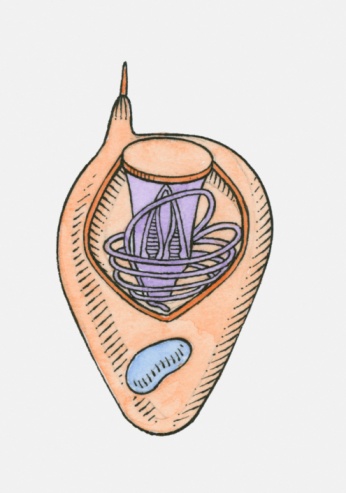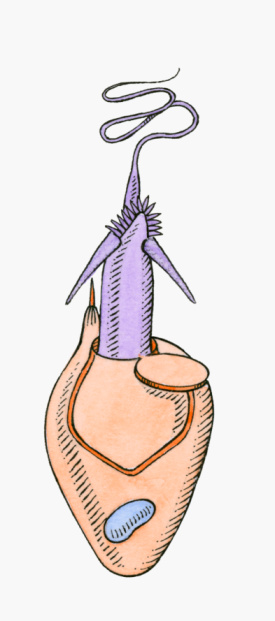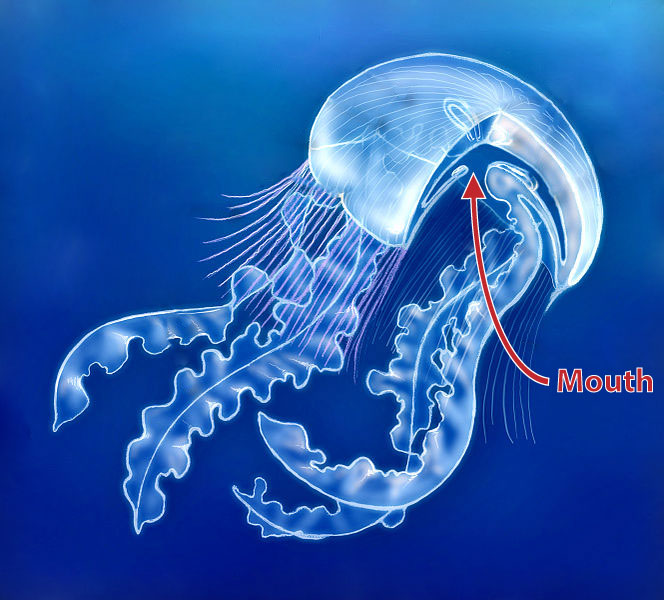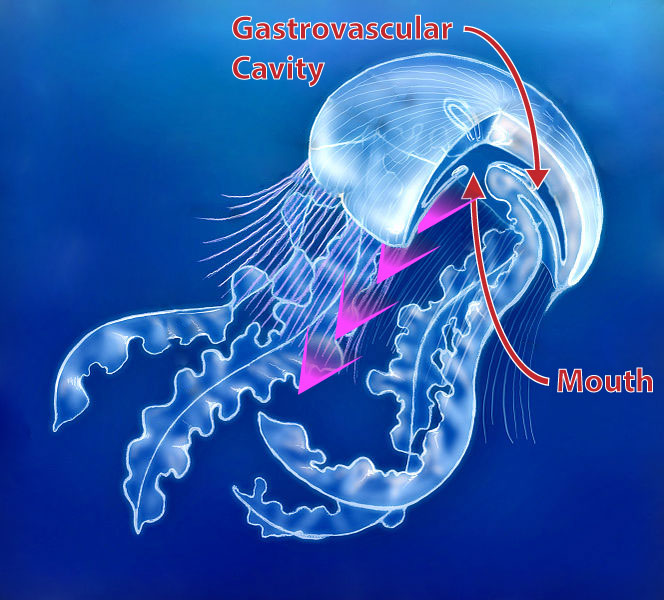Cnidarians have stinging cells all over their bodies and tentacles. These special cells act as a defense mechanism and as a mode of catching prey. In the activity below, click through the slides to learn about cnidarian stinging cells and their digestive process.
Trapping Food
Cnidocytes are the stinging cells of cnidarians and are the distinguishing feature of all animals in the Cnidaria phylum. Cnidarians capture prey by first entangling them in their tentacles covered in cnidocytes. Cnidocytes contain one organelle, the nematocyst. Nematocysts are tiny coiled barbed harpoons. On the outside of every cnidocyte is a bristle that acts as a trigger that releases the nematocyst with a quick and violent force when stimulated (when something touches it). The nematocyst contains chemicals that are sometimes toxic and some that merely stun the unfortunate animal that crossed the cnidarian's path. Pictured to the left is a cnidocyte (pink) containing non-discharged nematocyst (purple). To the right is a cnidocyte after it discharged the nematocyst. Define Cnidaria. Where does it get its name? Think of the answer, then click "Show Me" to see if you are correct.
Cnidaria is an animal phylum that contains jellyfish, corals, and sea anemones, and includes two body forms--medusa and polyp. All cnidarians have stinging cells, called cnidocytes that help them capture their food. These cnidocytes are where cnidarians get their name. Pulling Food into the Mouth
Once a cnidarian has ensnared its prey with its tentacles and injected it with a toxin that stuns or kills the animal, the cnidarian shovels its food into its mouth, pushing it in with its tentacles. The arrow in the blue image indicates the direction food is pushed into the mouth. How do cnidarians get food into their mouth? Think of the answer, then click "Show Me" to see if you are correct.
Cnidarians push food into their mouth with their tentacles. Digesting Food
Cnidarians are far more advanced in their digestive capabilities than any animals presented up to this point because they can digest food that's larger than their individual cells. This can be attributed to their gastrovascular cavity, a hollow space in their body used to digest food before it's taken up by their cells. Cells lining the gastrovascular cavity secrete enzymes into the cavity to break down the food. The important molecules and nutrients from the food are then absorbed into the body. Where is the site of digestion in cnidarians? Think of the answer, then click "Show Me" to see if you are correct.
Cnidarians digest food in their gastrovascular cavity. Excreting Waste
After all the nutrients from the food has been absorbed, the Cnidarian releases the digested food as waste, out the same hole the food entered--the mouth. Pictured is the direction the wastes exit the cnidarian. Where does cnidarian waste exit? Think of the answer, then click "Show Me" to see if you are correct.
The waste exits out the mouth. |
Jot down an answer to each of these questions--or say the answer to yourself--before clicking the question to check your understanding of cnidarians.
| Where does food enter and waste exit a cnidarian? | Food enters and waste exits the cnidarian's mouth. |
| What is a cnidocyte? | Cnidocytes are the stinging cells of cnidarians. |
| What is a nematocyst? | It is an organelle within cnidocytes and is a tiny coiled harpoon that, when released, discharges a chemical that can kill or stun the animal it stings. |
| What happens in the gastrovascular cavity of cnidarians? | The gastrovascular cavity is where cnidarian food is digested by digestive enzymes secreted by the cells lining the cavity. |
| How do cnidarians capture their prey? | Prey gets entangled in their tentacles, which are covered in cnidocytes. The cnidocytes release their nematocysts, which inject a toxin into the prey that kills or stuns them. |






